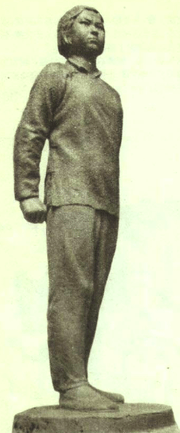Liu Hulan

Liu Hulan (刘胡兰, 1932–1947) was a young female spy during the Chinese Civil War between the Kuomintang and the Communist Party.[1][2] She was born in Yunzhouxi village, in the Wenshui County of the Shanxi province. She joined the Communist Party in 1946[3] and soon after joined an association of women working in support of the Liberation Army. She was actively involved in organizing the villagers of Yunzhouxi in support of the Communist Party of China. Her contributions involved a wide range of activities, such as supplying food to the Eighth Liberation Army, relaying secret messages, and mending boots and uniforms.
Death
On January 12, 1947, the Kuomintang army under Yan Xishan invaded her village in response to the assassination of Shi Peihuai, the village chief of Yunzhouxi, who was known to be loyal to the Kuomintang. Upon entering the village, Kuomintang soldiers rounded up several reputed Communist Party members believed to be involved of the assassination, among them the teenager Liu Hulan. The party members were decapitated in the town square. Before killing Liu Hulan, the executioners paused, giving her one final chance to renounce her allegiance to the Communist Party. She refused, and was immediately beheaded. She was 14 years old.
Significance
The life and death of Liu Hulan has become a symbol of the courage of the Chinese people, and is often cited as a homily of their loyalty to Communism. Her story is often told as an homage to the struggles endured, and the sacrifices made, for the cause of liberating China from centuries of rule by foreign powers. In recent history, Chinese political leaders have praised her heroism as the reason why the Chinese Communist Party has risen to take a dominant place in the politics and culture of modern China. It was in her memory that Mao Zedong wrote the famous line, "a great life, a glorious death" ("生的伟大, 死的光荣").
She is the subject of a 1949 opera, remade in 1954: Liu Hulan.
References
- ↑ "Liu Hulan - Chinese Young Heroine". http://history.cultural-china.com. Retrieved 2013-05-28. External link in
|publisher=(help) - ↑ "Liu Hulan". Retrieved 2013-05-28.
- ↑ "Liu Hulan". Chineseposters. Retrieved 2013-05-28.
- Hanyu Yueben. Shangwu Yinshuguan, Beijing: 1972. (Chpt 7, p32)